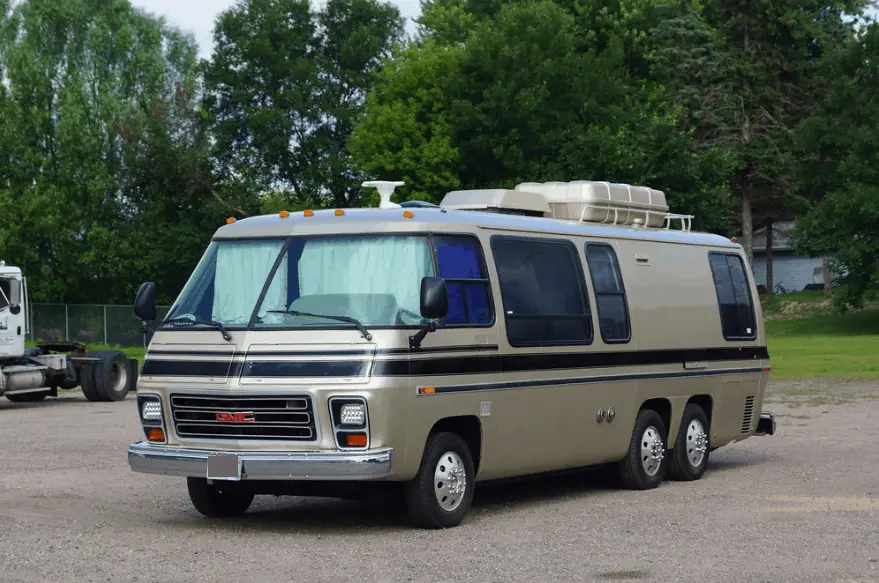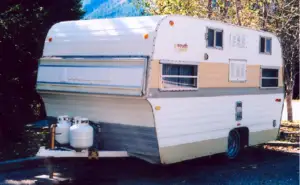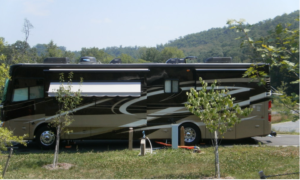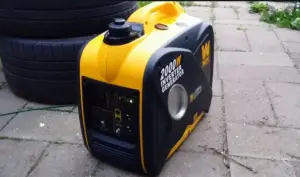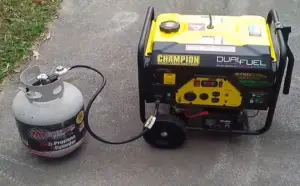RV’s or motorhomes are great outdoor camping vehicles. They come at a considerable investment, and it is precisely the reason you want it to last for a lifetime. They are sturdy vehicles and will last for a good long time, provided that you take good care of them.
When getting an RV, it is important to get informed on how to maintain it, or face some possibly significant issues. One of the most deceiving types of damage is to the roof, which may well start leaking.
Why Do RV Roofs leak
Why do RV roofs leak so often? There are many reasons and let me put forward all the reasons why it may leak.
The main reason for leaking RV roof is drying up and crumbling of caulking applied at locations where roof is pierced to add various items like roof vents, air conditioner, roof rack, roof ladder, and satellite antenna. Physical damage to the roof like brushing of tree branches, exposure to harsh weather and aging of the roof also results in leaks over time.
Lets now discuss each of these reasons and how to fix it.
1. Physical Damage
Well, this might be the most obvious reason. Physical damage is one factor that can strongly influence the appearance of roof leaks on your RV.
Large and significant accidents cause clearly visible dents on your RV, which usually tends to be fixed right away. On the other hand, it is the small accidents, like a small tree branch or twig falling on top of your RV, that might get you to overlook the situation.
However, these small incidents might actually become quite a big problem for you, by developing small ruptures that eventually degrade and later on cause major roof leaks.
2. Exposure to The Elements
Wind, rain, dust, sunlight, heat, storms and all elements of nature can be a major factor when it comes to creating small or large roof leaks in your motorhome or camper trailer.
Such elements can be very harsh and will slowly yet continuously cause damage to your RV. Thus, it is important that you anticipate this issue, by protecting your RV rooftop before embarking in a new trip.
In order to prevent this problem, you need to have a watertight seal. However, this seal is usually made from Caulk, a material that dries out over time and if not properly treated, will eventually degrade. So the recommendation is that you reapply the watertight sealing at least once a year.
3. Aging
RV or travel trailers can last long but with years, the aging of the RV itself can result in the roof becoming weak and start leaking. As it happens with everything, the aging process is one of the most relevant causes for issues that might appear in a motorhome or RV.
Old RVs can show many different problems, like for example, engine issues, oil drying up, breaks not functioning properly and of course, roof leaks. Exposure to the elements and heavy-duty trips are one of the greatest causes for the degradation of the RV over time and can sometimes result in many unwanted issues, like roof leaks.
Typically, travel trailers come with 4 different type of roofs. Each of these have their own pros and cons. How much a roof will last depends a lot on the type and the quality of the Materia used.
Below are the type of roofs and their pros and cons.
| Roof Type | Pros | Cons |
|---|---|---|
| Rubber EPDM | 1. Lightweight. 2. Better resistance to scratches and dents. | 1. Not a great finish. 2. Can absorb heat easily. |
| Rubber TPO | 1. Reflects heat. 2. Less expensive. 3. Works better with adhesive. | 1. Can degrade faster and result in leaks. |
| Fiberglass | 1. Lightweight, durable and rust resistant. | 1. Expensive for repairs. 2. Less heat resistant. |
| Aluminum | 1. Sturdy and less susceptible to damage. | 1. Absorbs heat. 2. Rusting can happen. |
4. Excessive Cargo
You get bigger RV’s like Class A or Class C motorhome and there are smaller RV’s like travel trailer or pop up camaper. They come in diffrent sizes and a compact RV can be hard to live in if you have lots of things to store.
When there is a lack of space inside the RV itself, people tend to attach the remaining needed cargo on the roof of the vehicle. It is usually an acceptable thing to do, if the cargo doesn’t weigh too much.
However, a heavy cargo might deteriorate your RV’s rooftop condition, as the maximum weight recommended is that of a regular human being. Therefore, overloading your Recreational Vehicle can result in many problems, namely roof leaks.
5. Careless Loading
If by all means you have to place some cargo on top of your RV’s roof, then you must pay very close attention to how you do it. This because carelessly placing cargo (whether it is light cargo or heavy cargo) on the roof can lead to scratches or dents on the RV, which will eventually lead to roof leaks.
6. Decorative Elements in Your RV
This doesn’t apply to all RVs, but some of them happen to have roof racks or wall racks to help maximise the stowage of all the things you usually need when travelling with an RV.
These racks are incredibly useful and allow you to have everything you need at a very easy to reach distance. However, these racks are usually attached directly to the roof of the RV. What this means is that the racks can probably be the cause of the leaks in your RV.
Of course the leaks won’t happen straight away, but with the wear, tear and weight that is placed on them, some crevices might start to appear, most likely around the screws.
7. Due to your RV’s Ladder
Most of the Motorhomes and RVs out there have a roof access ladder that easily allows you to get to the top part of your RV. Although it is a highly important and useful tool, the parts where the ladder joins the RV are vulnerable.
What that means is that the ladder’s mount points can become loose from the weight that is put on them every time someone climbs up or down the ladder, which can originate small entry holes and so, can become the source of the leaks inside your RV.
Detecting the RV roof leak
When the rv roof first starts to show signs of leaks it may not be easily detectable for you. It will go unnoticed untill you bump across something bigger to fix. The water may start dripping from the roof to the ceiling and can cause damages to the walls.
Such damages can result in molds and other issues which will be bigger pain for fixing. So how can you detect such leaks at earlier stages? Lets figure out some steps that you can take to detect it.
✔️ Inspecting or checking the roof regularly
Visually inspecting the roof is a simple yet effective way to detect the leak. Inspect seams, edges at air conditioners, antennas, roof vents for any signs of cracks or damages.
✔️ Check for soft spots
Soft spots are a great indication of water damages. Initially when the leak in its initial stages it may develop soft spot on walls or ceiling or floor. This gives a clear indication about leaking water. Check walls, roof, for any discoloration. Slide outs, walls, windows, or vents can be inspected for such signs of leaking.
✔️ Check exterior storage
Make sure you inspect exterior storage cabinets that can be showing signs of water damages.
✔️ Inspect interior for irregularities
Inspect the interior areas of the RV like water inlets, bathroom shower or furnace where the water damage signs could be present. Check cupboards or cabinet interiors for such water leakage signs.
Identifying such initial signs is important and if you are in doubt go for RV professional advice. At RV repair professional, you can ask for a smoke test or air-pressure test. This will help you ascertain the leaks.
For bigger and costly motorhome this is a crucial as their cost is very high. So if you own a costly class A motorhome or a fifth wheel, be sure to consult a RV professional if you have any doubt.
How to fix a leaking roof
So, as we saw the main step in fixing a RV roof leak is to identify the cause and then later go for the fix. If you feel the damage isn’t great then go for a temporary fix and then later try a permanent fix.
Watch below YouTube video on how to fix roof leaks, sealing and caulking the gaps, cracks using right products.
In either cases, its better to take professional advice if you aren’t sure or don’t have any prior experience in fixing or doing maintenance work on RV or camper. Lets see exactly how to seal an RV roof.
Doing the Temporary fix
You can use roof patch to fix the leaking roof. Many a times you may not have time to fix the roof and that’s when you simply put on a patch. You should however get a permanent fix as soon as you are done with your ongoing trip or when you get the time.
Tarping the RV: You can use tarping to protect the RV from leaking. This is a simple way to stop the leaking roof. But, you need to go for a permanent fix once you are ready.
Permanent fix
Fixing a roof with a permenant solution depends on the type of roof your RV or camper trailer has. A RV roof can be of different types as below.
Aluminum roof
This can be fixed using sealants. Be sure you have a fair idea about this type of roof else go for a professional repair.
Fiberglass
These are popular type of roofs in RV’s due to their distinctive advantages. For smaller holes and crack around vents you can use sealant. For bigger damage you can use fiberglass cloth. If you aren’t sure then go for a fiberglass repair professional.
Wooden roofs
These kind of roofs are less used but in case you have it on your camper then it must be leaking due to loose screws or damaged bolts. Thus you need to work on those damages. Or if the wood is rotten then be sure to replace it. This is mostly a DIY project but if you aren’t skilled with that then go for a professional who can work on such wood roof damages.
Rubber roof
Rubber roof can again be of different types. Leaks in rubber roof can be fixed using different kits that come as sprays or seals. A lot of products are available that can be used to fix the leaks.
Conclusion
Roof leaks in RV or even motorhomes are an inconvenience to those who own them and those who travel often in them. These roof leaks are known to appear due to a large number of factors, namely exposure to the elements, scratching, physical damage, excessive cargo, among other factors, and fixing these leaks can truly be a time-consuming process, especially if left untreated for a long period of time.
Roof leaks can lead to rotting of the vehicle and can damage the floor of the RV, where the dripping happens. Nevertheless, if a roof leak appeared on your vehicle, then the next obvious step is to fix it properly, so that it won’t happen again.

